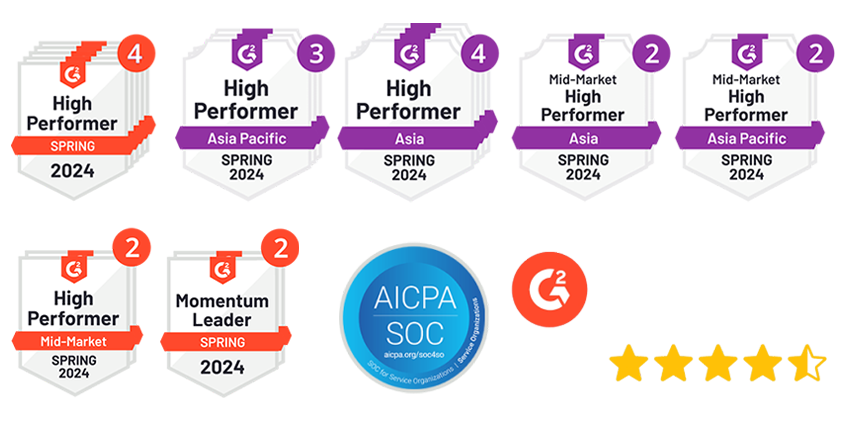Customer service teams face a persistent challenge: customers still prefer phone support for complex issues. Phone support remains the preferred channel for 81% of service professionals when handling complex customer issues. Despite all the digital communication options available today, voice interactions continue to be essential for resolving complicated problems that require nuanced understanding.
The problem gets worse when customers expect immediate assistance without long wait times. Traditional call systems create bottlenecks, leave customers frustrated, and stretch support teams thin. This is where AI voice agents for customer service offer a practical solution for support operations in 2025.
Voice AI technology now delivers 24/7 support, significantly reduces wait times, and provides the personalized experiences your customers demand. Unlike traditional call systems, AI customer service voice solutions can handle multiple conversations simultaneously while maintaining consistent quality. The momentum behind AI voice call center implementations is substantial, with 83% of decision makers planning to increase their AI investment in the coming year. This growing adoption reflects the real results businesses are achieving through AI customer service calls—from cost savings to improved customer satisfaction.
The Evolution of AI in Customer Service
Image Source: Yellow.ai
Customer service technology has come a long way from the early days of basic phone systems and rigid call scripts. What we’re seeing now is a fundamental shift in how businesses handle customer interactions, moving from inflexible automated systems to intelligent solutions that actually understand what customers need.
From IVR to AI voice call center systems
Interactive Voice Response (IVR) systems seemed like a breakthrough when they first appeared. These menu-driven systems allowed customers to navigate options using their phone keypads, promising faster service and reduced wait times. However, most enterprises still operate traditional IVR systems, but only 21% report satisfaction with their performance. The reality is that these rigid, menu-driven interactions often frustrate customers and create unnecessary escalations for support teams.
Anyone who has spent time pressing zero repeatedly to reach a human agent knows the frustration of traditional IVR systems. The robotic “press 1 for Spanish, 2 for English” experiences pushed customers to find workarounds rather than solutions.
Today’s AI voice agents work differently. These systems leverage natural language processing (NLP) to understand complex queries, adapt dynamically to changing topics, and provide contextually relevant responses. Rather than forcing customers through predefined paths, modern voice AI technology comprehends intent and context across multi-turn conversations. This means customers can speak naturally about their problems instead of navigating complicated menu trees.
Why 2025 is a turning point for voice AI
Several factors make 2025 a critical moment for voice AI adoption. Recent technological breakthroughs have produced high-performance, multimodal AI voice chat models that deliver near-instant responses with low latency, demonstrate high intelligence, quickly access documentation, recognize basic voice inflection, and support multiple languages.
The economics are equally compelling. The operating cost of core AI voice models per conversation hour now ranges from one-third to one-half the hourly rate of human agents based in locations like the Philippines. As AI compute costs continue to decrease with more efficient data centers and optimized models, the financial case for adoption becomes stronger.
Voice AI in 2025 has moved beyond scripted replies to dynamic, personalized interactions. These systems can skip unnecessary steps, route frustrated customers directly to live agents, and provide hyper-personalized service that adapts based on live customer behavior, sentiment, and context. This shift toward personalization is widespread, with 66% of global customer service managers optimizing AI using generative AI to increase personalization.
The rise of omnichannel support
Customers expect seamless transitions between communication channels. AI voice agents are now central to omnichannel strategies, maintaining conversation context across voice, chat, email, and social media platforms. This integration ensures customers receive consistent quality regardless of their preferred communication method.
The business impact is significant. Businesses that adopt omnichannel strategies see a 91% higher year-over-year increase in customer retention rates. Meanwhile, 73% of customers use multiple channels during their shopping journey. AI enables this unified experience by synchronizing support queries across platforms, ensuring that a customer who starts an inquiry on social media can seamlessly transition to phone support without repeating information.
This evolution toward omnichannel AI systems represents a major advancement in customer service operations. Instead of siloed experiences, customers now encounter a cohesive journey where their history, preferences, and current needs travel with them across every touchpoint, creating a connected customer experience that actually works.
How AI Voice Agents Actually Work Behind the Scenes
Image Source: Biz4Group
Behind every seamless AI customer service interaction lies a sophisticated technology stack working in perfect harmony. AI voice agents operate through a complex orchestration of multiple technologies that convert spoken language into actionable responses within milliseconds.
1. Speech recognition and intent detection
The journey of an AI voice call begins when a customer speaks. Automatic Speech Recognition (ASR) systems capture the audio input and convert it into text. Modern ASR technology can accurately process various accents, filter background noise, and even distinguish between multiple speakers. This transcribed text then moves to Natural Language Processing (NLP) systems that analyze the syntax and semantics of the language.
Following the initial transcription, Natural Language Understanding (NLU) components delve deeper to grasp the user’s intent—essentially, what they actually want to accomplish. This technology enables AI voice agents to comprehend nuanced requests, identify important details, and understand context even when faced with ambiguous language. The most advanced systems now achieve 99% accuracy in interpreting user queries, even during multi-step conversations.
2. Accessing knowledge bases in real time
Once the customer’s intent is clear, AI voice agents for customer service tap into their knowledge repositories to formulate responses. These knowledge bases serve as centralized information hubs containing FAQs, product details, troubleshooting guides, and company policies. As soon as a user’s spoken input matches a configured trigger prompt, the system automatically searches the attached knowledge base and delivers the most relevant answer.
Knowledge bases can be customized for specific departments or services, ensuring responses remain relevant to each agent’s domain. Modern systems employ retrieval-augmented generation (RAG) to access hyper-relevant internal information, maintaining accuracy and context awareness. This dynamic syncing capability means companies don’t need to manually update AI agents when information changes—the system automatically incorporates the latest content.
3. Executing tasks and actions via voice
Beyond providing information, AI voice agents can perform actual tasks through a process called dialog management. This component decides the appropriate response based on:
- User history and previous interactions
- Current conversation context
- Business rules and predefined workflows
To complete actions like rescheduling appointments or processing refunds, AI agents utilize API orchestration to connect with backend systems. The agent accesses relevant platforms (like CRM systems or scheduling tools), verifies data, makes necessary changes, and confirms completion—all without human intervention.
Throughout this entire process, from speech recognition to task execution, AI voice technology operates at high speed, ensuring natural, conversational customer interactions that feel remarkably human.
Proven Benefits Backed by 2025 Data
The results speak for themselves. Businesses implementing AI voice agents for customer service are seeing measurable returns across multiple performance indicators in 2025.
1. Cost savings for support teams
The financial impact of voice AI technology is substantial. Companies utilizing AI-powered customer service tools report up to 70% reduction in operational expenses and 25% decrease in staffing costs. AI automation can cut support-related costs by approximately 25% annually. Businesses automating call operations with AI voice call center solutions achieve nearly a 90% reduction in operational costs compared to traditional call centers. By 2026, businesses are projected to save $80 billion in labor costs through AI implementation.
2. Improved agent productivity
AI voice agents enhance human work rather than simply replacing it. According to the National Bureau of Economic Research, customer support professionals with access to AI agents experience productivity increases of 14% on average. Some companies report productivity boosts of up to 400%, with AI saving businesses approximately 2.5 billion hours annually. One employee can initiate 20 calls simultaneously with AI assistance, watching progress and intervening only when necessary.
3. Faster resolution times
Voice AI technology resolves customer issues 40-50% faster than conventional IVR systems. Organizations implementing AI voice agents for customer service report a 40% decrease in resolution times, allowing customers to quickly address their concerns. Companies using AI contact enrichment experience a 50% reduction in response time to customer inquiries. Peakflo’s AI Voice Agents answer routine inquiries 24/7—no ticket backlog, no burnout.
4. Better customer retention rates
AI voice agents improve customer loyalty with measurable results. Research shows that increasing customer retention rates by just 5% can boost profits by up to 25%. A 10% increase in retention can result in a 30% increase in company value. Companies using proactive AI-driven customer service reduce churn rates by up to 30%. Businesses implementing AI report a 67% increase in after-hours satisfaction and 25% increase in customer satisfaction scores across all segments, with some seeing CSAT improvements of 12% following AI voice agent deployment.
Real-World Use Cases Across Industries
Image Source: Market.us
AI voice agents for customer service are solving real business problems across multiple industries in 2025. These practical applications show how voice AI has moved from experimental technology into essential business infrastructure that delivers measurable results.
1. Retail: Handling order status and returns
Retail businesses deal with constant pressure from order tracking requests, return inquiries, and product information questions. Voice AI technology now handles these repetitive queries automatically, reducing missed calls and eliminating wait times, even after business hours.
AI agent can greet callers using full customer context and independently assist with accounts, orders, and rewards. Implementation of AI agents can successfully ddeflect85% of order and delivery FAQs from support teams.
Voice AI Agents resolve common questions, capture intent, and escalate complex cases to the right human rep with full call history. This capability proves particularly valuable when customers use phrases like “I need to speak with someone about a damaged item I received twice already,” as the system intelligently routes these complex issues to human agents with complete context.
2. Healthcare: Appointment scheduling and reminders
Healthcare providers face scheduling bottlenecks that frustrate both patients and staff. Voice AI agent books appointments by phone, removing wait time bottlenecks for patients and providers. This voice assistant engages conversationally to make appointments 24/7, freeing up staff for more complex patient interactions.
Early adopters report AI voice agents resolve up to 70% of scheduling calls without staff intervention, with the average call successfully completed in under three minutes and thirty seconds.
2. Banking: Account inquiries and fraud alerts
Financial institutions employ customer service voice systems for numerous high-volume inquiries. Banking AI agents provide instant, personalized service using customer data to deliver contextual recommendations. They efficiently handle routine tasks like account balance checks, branch hours inquiries, and loan payments.
AI systems detect and alert customers to potential fraud, offering swift action options. Research shows financial services firms using AI reduce costs by 29% while improving customer satisfaction by 41%.
3. Travel: Booking changes and flight updates
Travel companies face constant disruptions that require immediate customer communication. AI voice call center technology helps manage these disruptions and itinerary changes effectively. AI agents inform travelers about upcoming changes and prompt them to make alternative arrangements.
These systems provide real-time updates on flight status, including delays, cancellations, and gate changes. AI voice agents efficiently handle baggage tracking, providing updates on lost items and guiding customers through retrieval processes. These capabilities prove especially valuable during high-demand periods like weather disruptions when swift, accurate support becomes critical.
Best Practices for Using AI Voice Agents Effectively
Getting the most from your AI voice agents for customer service requires more than just implementation. Companies that approach these systems strategically see substantially better results than those who treat AI voice systems as plug-and-play solutions.
1. Personalizing the AI customer service call
Standard AI customer service calls can feel generic and impersonal. The solution is to allow your AI agents to access historical data and past interactions to guide conversations and responses. This approach helps tailor interactions to individual customer expectations and preferences.
Your AI customer service voice systems should greet customers by name and reference previous purchases or support history. For example, “Hi Priya, I see you raised a ticket yesterday about your subscription. Let me check the status for you”. This personal touch creates a more meaningful customer experience.
2. Training the AI with real customer data
Effective voice AI technology depends on comprehensive training with authentic customer interactions. The most effective approach involves a two-step process: first, fine-tune your AI using thousands of real-world call transcripts to improve understanding of customer queries and industry-specific language. Subsequently, utilize prompt engineering to refine how the AI responds in different contexts without requiring full retraining.
Implement feedback loops where human agents review AI responses and provide corrective input, especially to prevent hallucinations—instances where models generate incorrect information. This ongoing refinement ensures your AI agents stay accurate and helpful.
3. Seamless integration with CRM and support tools
Your AI voice call center solutions must connect smoothly with existing systems. Before integration, audit your CRM to clean up outdated fields and duplicates. Clearly map what data should flow to and from the voice agent. Choose AI tools that align with your current business needs, CX strategies, and service software.
This integration enables AI agents to pull customer information in real-time, creating more meaningful interactions. Without proper integration, your AI agents operate in isolation, missing critical context that could improve customer experiences.
4. Escalation protocols to human agents
Even the best AI systems need clear handoff procedures. Design escalation protocols for situations when:
- The customer explicitly requests a human agent
- AI detects frustration through sentiment analysis
- Complex issues arise beyond AI capabilities
- Multiple fallback responses occur in succession
Position escalation as a service enhancement rather than an AI failure with phrases like: “It looks like this request needs special attention. Let me connect you to the best person to help with this”. Ensure agents receive conversation summaries so customers don’t repeat information.
These practices help create a smooth experience where technology enhances rather than replaces human expertise when needed.
How to Successfully Implement AI Voice Agents
Implementing AI voice agents for customer service requires a systematic approach. Organizations that approach implementation strategically see better results than those that rush into deployment without proper planning.
1. Choosing the right platform and tools
Selecting the appropriate platform sets the foundation for successful deployment. Evaluate AI platforms based on compatibility with your existing tech stack, scalability for business growth, and integration capabilities with other tools and applications. A straightforward, intuitive user interface is essential for managing and customizing your AI voice call center system. Additionally, compare pricing structures to find options offering the best value for your specific use cases. The platform you choose will determine the quality of AI agents you build, making this a decision you cannot afford to overlook.
2. Defining clear goals and KPIs
Before implementation, establish clear objectives for what your voice AI technology should accomplish. Common goals include reducing response times, improving customer satisfaction, or automating routine inquiries. Beyond setting goals, identify specific KPIs to measure success:
- Operational efficiency metrics (resolution rates, handling time)
- Customer satisfaction indicators (CSAT, NPS)
- Financial impact measurements (cost savings, ROI)
Tracking KPIs provides concrete evidence of return on investment, validating your expenditure and demonstrating the value delivered by the AI system.
3. Training and testing the AI agent
Train your AI customer service voice system through a two-step process: first, fine-tune a large language model using real-world call transcripts; then, use prompt engineering to refine how the AI responds in different contexts. Before full deployment, conduct thorough testing with internal users. Create test scenarios for both common and edge-case conversations, and ask team members to interact with the bot and provide feedback on tone, flow, and understanding.
4. Monitoring performance and iterating
After launch, continuously track performance metrics and gather insights from customer interactions. This approach helps you identify areas for improvement and optimize your AI customer service call system over time. Effective AI agent performance tracking requires careful integration with existing systems and ongoing optimization.
How Peakflo AI Voice Agents Elevate Customer Service
Peakflo’s AI Voice Agents revolutionize the way finance and customer-facing teams handle inbound and outbound calls. These advanced voice agents are not mere rule‑based bots—they combine voice, WhatsApp, and SMS capabilities to simulate a human-like teammate that interacts naturally and conversationally.

24/7 Personalized Support
Available around the clock, Peakflo agents never sleep or take breaks. They seamlessly handle invoice reminders, sales follow-ups, and basic customer queries, giving businesses constant availability without the cost of extra headcount.
Remarkably Human
Many customers report not even realizing they were speaking with AI. Thanks to real-time adaptation and contextual memory, the conversation flows naturally. Agents remember interaction histories and escalate only when necessary, crafting a seamless, human-like experience.
Boosted Efficiency & Cash Flow
By letting AI take on repetitive tasks, teams can complete 50–250 calls per day without adding staff, accelerating collections, and enhancing cash flow. Human agents are freed up to focus on complex issues and relationship building.
Multilingual & Globally Accessible
These agents support global operations by operating in multiple languages and time zones. Their 24/7 functionality with multilingual fluency ensures global customer reach regardless of geography.
Deep Integration & Automation
Peakflo integrates smoothly with ERP systems like SAP, Oracle, NetSuite, and Microsoft Dynamics, syncing live with workflows. It automates escalation, dispute resolution, and payment updates—all while tracking calls and updating records in real time.
Ready to experience AI agents that sound and work like real team members? Schedule a demo and see how Peakflo can transform your customer service operations.
Conclusion
AI voice agents have moved from experimental technology to practical business solutions in 2025. These systems now deliver measurable results across industries while addressing the core challenges that have frustrated customer service teams for years.
The evidence is clear. Companies implementing AI voice agents report significant operational cost reductions alongside improvements in agent productivity and customer satisfaction. These systems resolve issues faster than traditional IVR systems while boosting retention rates—a critical factor considering that even a 5% increase in retention can substantially boost profits.
AI voice technology represents a practical shift in how businesses connect with customers. Companies that implement these solutions now position themselves to deliver the immediate, personalized service that customers expect. The question has shifted from whether AI voice agents work to how quickly your business can implement them effectively.
FAQs
Q1. What are the main benefits of using AI voice agents for customer service in 2025?
AI voice agents offer significant cost savings, improved agent productivity, faster resolution times, and better customer retention rates. Companies report up to 70% reduction in operational expenses and 14-400% increases in productivity. These systems can resolve issues 40-50% faster than traditional IVR systems while boosting customer satisfaction.
Q2. How do AI voice agents work behind the scenes?
AI voice agents use speech recognition to convert spoken language into text, then employ natural language processing to understand intent. They access knowledge bases in real-time to formulate responses and can execute tasks through API integrations with backend systems. This process happens within milliseconds, enabling natural, conversational interactions.
Q3. In which industries are AI voice agents proving most effective?
AI voice agents are delivering measurable results across multiple sectors. In retail, they handle order status and returns. Healthcare providers use them for appointment scheduling and reminders. Banks employ AI agents for account inquiries and fraud alerts. Travel companies utilize them for booking changes and flight updates.
Q4. What are some best practices for implementing AI voice agents?
Key best practices include personalizing interactions using customer data, training the AI with real customer interactions, seamlessly integrating with existing CRM and support tools, and establishing clear escalation protocols to human agents when needed. It’s also crucial to choose the right platform, define clear goals and KPIs, and continuously monitor and improve performance.
Q5. How accurate are AI voice agents in understanding and responding to customer queries?
Modern AI voice systems have achieved remarkable accuracy. The most advanced systems now reach 99% accuracy in interpreting user queries, even during multi-step conversations. They can understand various accents, filter background noise, and grasp nuanced requests. However, it’s important to have escalation protocols in place for complex issues that may require human intervention.










![Why AI Sales Calls Are Making Good Sales Reps Even Better [2025 Guide] ai sales calls](https://blog.peakflo.co/wp-content/uploads/2025/09/65168cf6-3001-4733-8cbc-12d5684cf449-218x150.webp)


































